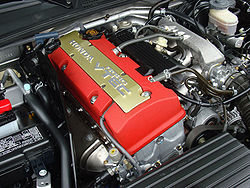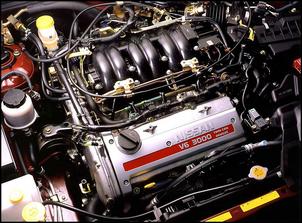
F22C
In 2004, Honda produced a stroked 90.7 mm (3.57 in) version of the F20C, increasing displacement by 160 cc (9.8 cu in) to 2,157 cc (131.6 cu in). Dubbed the F22C1, it was originally designed for the North American market being introduced for the 2004 model year. Rated torque increased from 153 ft·lbf (207 N·m) at 7500 rpm for the F20C to 162 ft·lbf (220 N·m) at 6200 rpm for the F22C. The redline was reduced from 9000 rpm to 8000 rpm, mandated by the longer travel distance of the pistons. Peak horsepower output is rated identical to the F20C.
The F22C1 was used exclusively in the North American market for 2004 and 2005 with the F20C being used in all other markets. Despite the displacement increase, the car to which the F22C1 is mated retains the name of Honda S2000. In 2006, the engine fully replaced F20 engines in the Japanese market as well which resulted in a drop in rated power output from 250 PS (247 bhp) to 242 PS (239 bhp) due to compression being reduced from 11.7:1 to 11.0:1. The UK, European, and Australian markets are currently the only areas in which the S2000 retains the F20C.
Haha yes
B234R
The longer stroke B234R was last produced in 1998
The B234R was selected as one of Ward’s 10 Best Engines for 1995 and 1996.
B234R used a Mitsubishi Heavy Industries TD04HL-15T-6cm2
Specifications Engine Torque Power Compression ratio Boost pressure
B234R: 342 Nm @ 1950 rpm 225 hp (168 kW) @ 5500 rpm 9.25:1 1.08 bar
“I chopped it up a bit.”
How does it feel that the only person reading your posts is you?
The VQ is a V6 piston engine produced by Nissan with displacements varying from 2.0 L to 4.0 L. It is an aluminum block DOHC 4-valve design with aluminum heads. It is fitted with Nissan’s EGI/ECCS sequential multi-point fuel injection (MPFI) system. Later versions feature various implementations of variable valve timing and replace MPFI with direct fuel injection (marketed as NEO-Di). The VQ series engine was honored by Ward’s 10 Best Engines list every year from the list’s inception until 2008.
The 3.0 L (2987 cc) VQ30DE has a bore and stroke of 93 mm and 73.3 mm respectively with a compression ratio of 10.0:1. It produces 193 PS (142 kW; 190 hp) to 230 PS (170 kW; 230 hp) @ 6400 rpm and 205 to 217 ft·lbf (278 to 294 N·m) @4400 rpm. The VQ30DE was on the Ward’s 10 Best Engines list from 1995 through 2001. It is an aluminum open deck block design with microfinished internals and a relatively light weight.
An improved version of the VQ30DE is known by the designation VQ30DE-K. The K designation stands for the Japanese word kaizen which translates to “improvement”. The engine was used in the 2000–2001 Nissan Maxima and adds a true dual-runner intake manifold for better high-end performance compared to some earlier Japanese and Middle-East market versions of this engine. The VQ30DEK produces 226 PS (166 kW; 223 hp). The 1995–1999 US spec VQ30DE was equipped with only a single runner intake manifold.
It is fitted to the following vehicles:
- 1994–1998 Nissan Cefiro (A32), 220 PS (160 kW; 220 hp) and 206 ft·lbf (279 N·m)
- 1995–1999 Nissan QX (A32)
- 1995–1999 Nissan Maxima (A32), 192 PS (141 kW; 189 hp) and 205 ft·lbf (278 N·m)
- 1996–1999 Infiniti I30 (A32), 192 PS (141 kW; 189 hp) and 205 ft·lbf (278 N·m)
- 2000–2001 Nissan Maxima (A33), 225 PS (165 kW; 222 hp) and 217 ft·lbf (294 N·m); 230 PS (170 kW; 230 hp) for Anniversary Edition SE
- 2000–2001 Infiniti I30 (A33), 230 PS (170 kW; 230 hp) and 217 ft·lbf (294 N·m)
- 1999–2003 Nissan Bassara U30, 223 PS (164 kW; 220 hp) and 206 ft·lbf (279 N·m)
- 1998–2003 Nissan Presage U30, 223 PS (164 kW; 220 hp) and 206 ft·lbf (279 N·m)
VQ30DE-K pictured:

thats why i gave cliff notes :lol
:rofl
There is no Wiki specifically for the M96.70, just like there is no Wiki specifically for the EG33.
No love for the boxer six ![]()
There’s noting in wiki for my engine other than the hp/tq/cc
N51B30 SULEV
Such a thrilling article…
The 94:
G13B
This DOHC 16-valve engine is well known, it uses the older distributor driven off the intake camshaft, and produces approximately 100 hp(74 kW) @ 6500rpm / 83 ft·lb(112Nm) @ 5000rpm. Redline is set at 7400-7600RPM. Like many DOHC engines, this engine has an interference valvetrain design, making periodic timing belt changes vital to the engine’s life.
The 99 and 01:
G13BB
The SOHC 16-valve G13BB has electronic MPFI Multi-point fuel injection, generating 56–59 kW (75–79 hp) at 6,000 rpm and 104–115 N·m (77–85 ft·lbf) at 4,500 rpm. The G13BB has 2 coil packs bolted directly to the valve cover, although early models still had the coil packs mounted to the left side of the head, traditionally where the distributor was located. This engine uses a MAP sensor to monitor manifold pressure, unlike the G16 series. This engine has a non-interference valvetrain design. It uses the same G series block found in many other Suzuki models and so it is a popular conversion into the Suzuki Sierra 4wd, which uses either a G13A(85-88) or G13BA(88.5-98). This allows the engine to fit into the engine bay simply as engine and gearbox mounts are identical and both engines are mounted North-South.